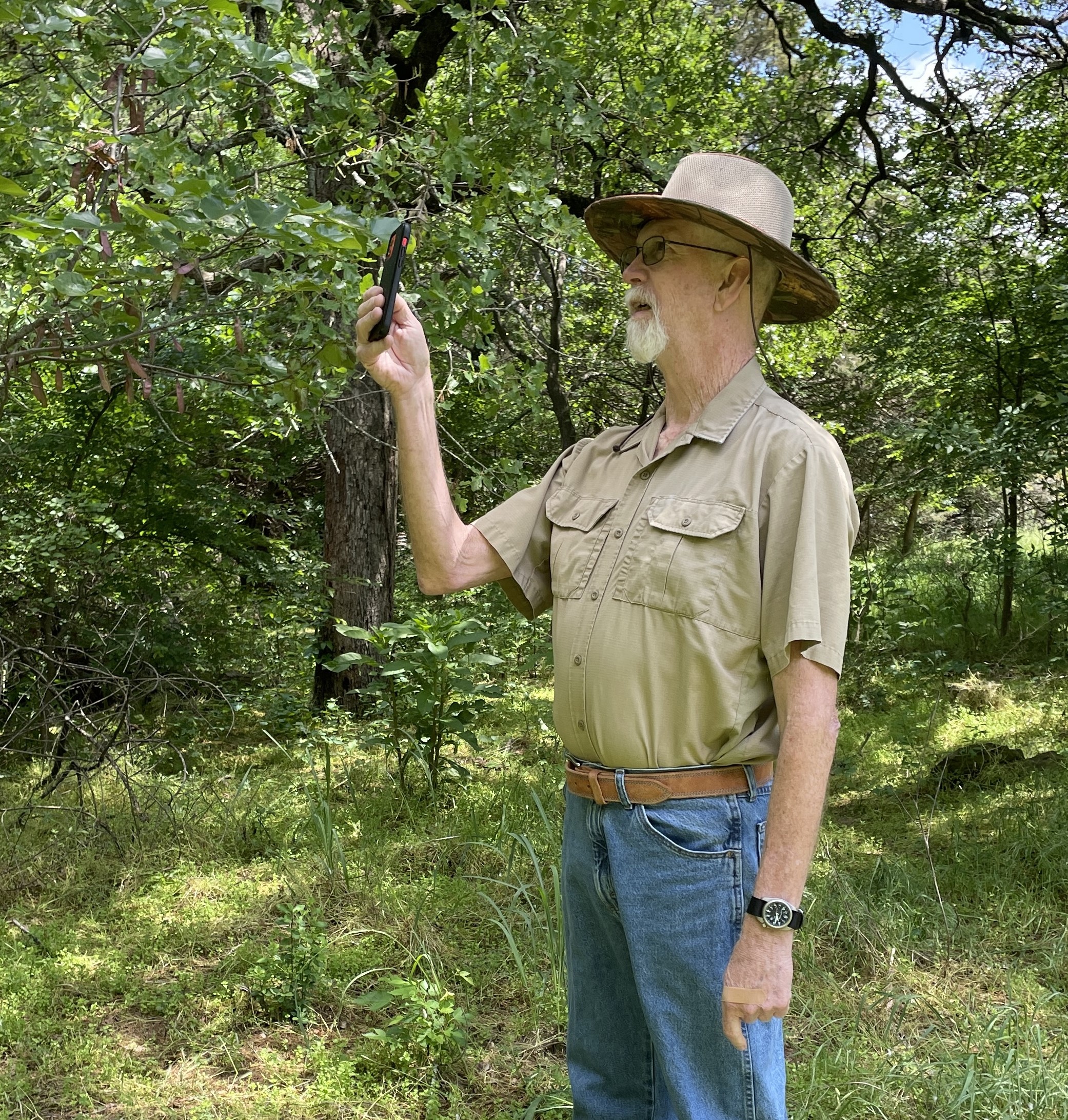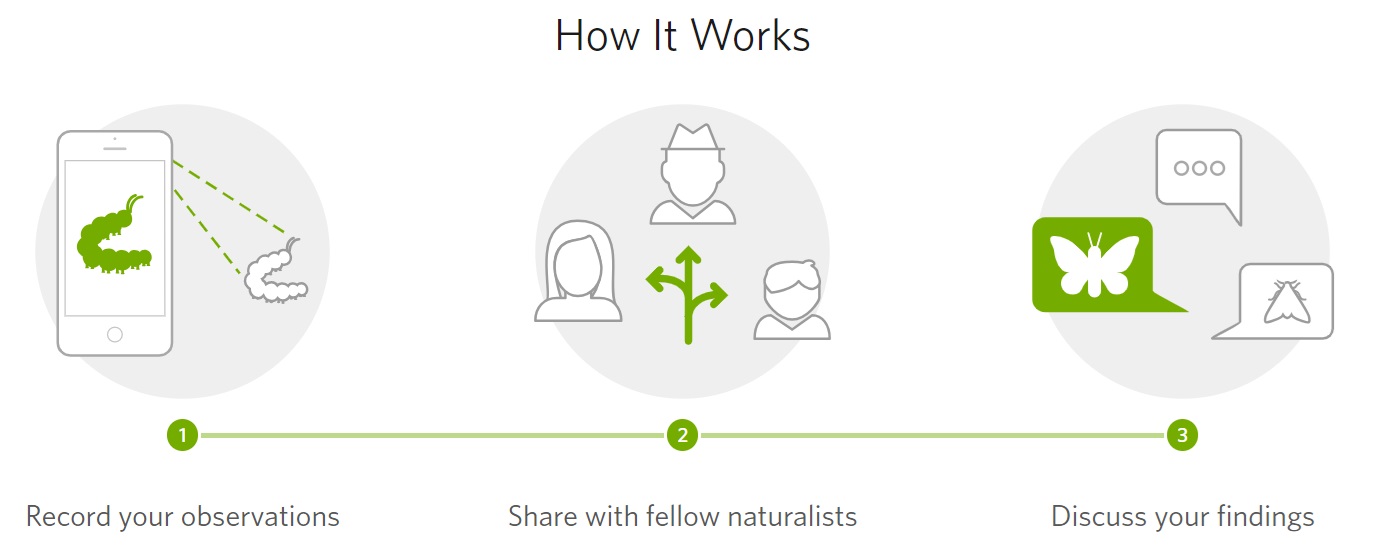Free Birding APPS from Cornell Lab
For help with bird identification, download the Merlin App. It includes a feature that lets you record bird songs and will identify the species of all the birds you hear. To keep a life list of the birds you’ve seen, download the eBird App, where you can log your sightings and contribute to scientific research through citizen science. Both apps are free but require a free eBird account.
Identifying Plants and Other Wildlife with iNaturalist:
The iNaturalist SEEK App is also free and helpful for identifying plants, animal tracks, bugs and other wildlife. The iNaturalist App records your findings and allows you to contribute to citizen science research. Both apps are free but require a free iNaturalist account.
Note: The SEEK App has a helpful option in the settings, which makes it much easier to use. When the App first opens, click the ellipses to visit settings, and turn on the option to "Automatically take a picture then the identigication reaches species." The following article offers suggestions on how to use the apps mentioned above, along with the resources on this website, to introduce children to nature.
Learn More about iNaturalist.
The World’s Happiest, Slightly Blurry Raccoon:
How I Connected with Grand #6 Through Nature and an Old, Forgotten Camera

I have nine grandchildren, and connecting with them has been a struggle. I have no idea what they’re into—whatever it is, it’s nothing like what I was doing at their age. I had a garden hose and a wagon for my frog collection, a whole city block of children to play with, and one very strict rule: race home when the streetlights came on.
My Mom was clever and wise. She would throw us out after breakfast: “Grandma is coming today! You need to make the welcome signs and greet her when she arrives!” She’d have everything set up outside—poster boards, markers, paint, streamers, you name it. If we came in for a glass of water, she would fuss: “You're going to miss Grandma!” There were brooms, buckets, and the stench of ammonia everywhere in that house. Grandma didn’t show up until dinnertime. We had a blast. I didn’t figure her out until I had a kids of my own!
On rainy days, she lined our shoes with repurposed bread bags to keep our feet dry, and we were out there—racing sailboats made from egg cartons in the stream that formed along the curb. We were never concerned with the heavy city traffic on our street; drivers waved and smiled as they carefully rolled by.
Every fall, Mom hosted the annual chestnut-collection competition for what felt like every kid in Erie, Pennsylvania. It was hard work, with all of us competing to be the Chestnut Champion of the Year. There was no title for second place, no such thing as a "participation award." I either won the title or strategized for the following year—mostly scheming to sabotage my brothers, but that's beside the point.
Mom’s strategies wouldn’t work with today’s kids. A sign for Grandma is indoors, a PowerPoint with someone else’s clip art. If you ask a kid how many chestnuts would fill a bushel, they won’t grab a bucket and start digging in the dirt—they’ll ask Siri, and accept her answer as if it were the Word of God.
Today's children spend less time outside, immersed in nature, than any generation in human history. This problem is becoming increasingly difficult to remedy, as natural spaces—free of traffic and city noise—become harder to find. I volunteer for refuge school and youth group field trips, and a comment I have often heard breaks by heart:
“We have never walked on a dirt trail before.”
The first time I heard that comment--from a student and their parent--I didn’t believe it. I do now: trails in city parks are concrete, everything is getting paved. Children hardly ever play in the dirt anymore, and they’re losing touch with nature.

Grand #8: Luna loves her "Dirt Learning" preschool — just mud, toys, and not much else. Many European preschools include Waldtage — a full day each week spent outside, in natural spaces, regardless of the weather. There is no such thing as bad weather, only inappropriate clothing.
Solving this problem takes finesse—marching the children blindly into the forest won't work. Mom knew: children need a mission with an end goal. It doesn’t matter what the mission is, or even if they complete the mission, they just need to have one. The fun is in the preparation, the hunt for the goal, not the goal itself. Unfortunately, I did not figure this out until Grand #6: 11-year-old Trey, and we are having a blast!
In the beginning, I tried to engage the Grands with Hagerman Tram Tours. Though wonderful, the tours are suited for adults. The children were bored, their faces buried in their phones. Eventually I gave up trying to distract them from their devices: unplugging my router and lying about an “outage” just wasn’t working anymore. Instead, I began including their devices in our missions by loading their phones with free birding apps and nature resources. We started with Merlin and SEEK.
Trey dove into all the bird facts and photos on the Merlin app — he was hooked, playing bird songs from all over the country like it was his new favorite playlist! The ability to identify birds by their songs really lit him up — it was the first time he knew something his mom didn’t! But I quickly saw he needed a bit more focus. Though the American Bittern has a really cool song, it’s unlikely Trey will ever hear one in the wild. We needed something to look for, a goal with a vague possibility of success.
I turned to Jack Chiles and the census team: every Tuesday they conduct an in-depth bird count and survey of this entire refuge. That list is a gold mine for us! Every Wednesday morning I print out Jack’s field notes and the complete bird census list from the day before. “Here Trey, listen to these bird songs, learn what they sound like. Jack saw 13 Blue Grosbeaks! They’re here right now, let's go find them!” Whether we find them or not doesn’t matter, we’ll have a blast looking, and we always find something.
|
|

Eastern Tiger Swallowtail by Trey
|
After choosing a bird from the census list, we research its range, habitat, and identification infomation on Merlin. When we're in the field, Merlin is incredibly helpful — it records the sounds of nearby birds and identifies them by their songs. We also enjoy using the SEEK app to identify all our cool finds—plants, insects, and animal tracks. Finding the desired habitat for our chosen creature is a lot of fun, too. Sometimes Trey will ask the helpful Visitor Center volunteer for advice on where to find a certain habitat. I know this refuge like the back of my hand, but I stay silent—I enjoy watching Trey practice autonomy and figure things out on his own.

Trey and I often begin our adventures before sunrise at Picnic Pond—the perfect spot to find deer coming in for a drink. Photo by Murali Hanabe.
Thankfully, the US Fish and Wildlife Service and the original creators of this website have provided a wealth of information about the refuge’s wildlife—everything needed for an excellent creature-finding adventure. Check out the Flora and Fauna menu choice on this very page. There are informational guides for wildflowers, birds, mammals, reptiles, etc. You will find entire pages of beautiful, named photos of butterflies and dragonflies, courtesy of Hagerman’s butterfly expert, Laurie Sheppard, and other talented photographers. Another resource: trained garden docents at a Hagerman Butterfly Garden Walk (the next one is Saturday, June 14th, 2025). The Friends of Hagerman, with their mission of environmental education, offer a wealth of information and, more importantly, realistic goals for entire days of joyful explorations!
The best tool for engaging with my grandson through nature turned out to be a twenty-year-old digital camera, discovered during spring cleaning a few years ago at the bottom of a closet. It still worked! This discovery has been life-changing for Trey and has improved our relationship tremendously. The autofocus digital camera, paired with a zoom lens and a monopod to keep it steady, works perfectly for him. He has a much easier time focusing on specimens with the camera—he's never been great with binoculars. Thank goodness it has a digital menu—Trey was all over it! He learned quickly and took decent, though slightly blurry, photos on our very first day out!
|
|
|
|

Trey snapping this photo of a
Blue-faced Meadowhawk Dragonfly
|
These days, a big part of our goal is always to replace Granny's Facebook profile pic. I have been a Lotus Flower, an Eastern Tiger Swallowtail, a Blue-faced Meadowhawk Dragonfly and many others. I refuse to be any species that isn’t native. We use our phone apps and wildlife guides to confirm our IDs and thoroughly research our subjects.
My favorite profile pic, without a doubt, is the very first photo Trey ever took. I will never forget that moment. We had just arrived at the south entrance on Bennett Lane. We hadn’t yet discovered all the resources—or the importance of having goals. Honestly, I had no idea what we were going to do. I was just driving around, looking for anything, when suddenly: "Granny! Stop the car! Go back! A little more... stop!" Click, click, click, click—a million clicks of a raccoon poking his head out of a tree cavity. Trey had already figured out how to balance the camera perfectly on the open car window, using the monopod for support on the floorboard.
|
|
|
|
That entire day Trey was in control, and I was more than happy to be his chauffeur. I took him wherever he wanted to go; I dutifully followed his orders as we drove around searching for the perfect photo. For Trey, being in control all day was a rare and exciting treat.
Over time, and after many amazing days in nature, a truly beautiful thing happened: his confidence grew. He started deciding what to find and where to find it, and he was confident that we would succeed. His confidence in his photography skills also soared: instead of a million clicks, it was one—maybe two.
"I got it, Granny, let's go."
|
All of my Grands have taught me a thing or two about introducing kids to nature. One big lesson? Preparation is everything—and comfort can make or break the adventure. I recommend a backpack full of snacks and plenty of water. If the kids aren’t having fun—or if they’re too hot, cold, wet, or hungry and there’s no way to fix it—abort the mission. Try again a different day.
Remember, this is a wildlife refuge where all native species are protected, including Toxicodendron radicans (Poison Ivy) and Crotalus horridus (the Timber Rattlesnake). Mud boots are the safest; sneakers are fine on the nicely mowed trails, but please—no sandals or flip-flops. Teach the children to stay aware and stick to the trail. Don’t forget insect repellent, sunscreen, hats, and long pants—plus a picnic to enjoy on the Visitor Center's patio with a gorgeous view of the lake. There’s no food for sale at the refuge, but there is a water bottle refill station. When the kids find something interesting, snap a photo and put it back where it belongs. Take only pictures, leave only footprints.
|
|
|

The iNaturalist Community: Connecting People to Nature While Expanding Biodiversity Knowledge
By Kathy Whaley, Refuge Manager

Although iNaturalist.org has been around since 2008, many nature enthusiasts are just now learning about this unique resource. So, what is iNaturalist, how does it work, and how can it help me become a better naturalist?
iNaturalist, a 501(c)(3) nonprofit organization, is an online network of “observers” who make records of most any living thing on Earth worldwide. It includes species of birds, mammals, plants, reptiles, amphibians, butterflies, moths, insects, fish, fungi, lichens, mollusks, and even protozoans. So far more than 3 million observers have recorded almost 470,000 species throughout the world. In Texas alone, 67,000 registered observers have identified 28,281 different species to date. Looking more locally, as of late April 2024 Grayson County had 2,541 observers who had recorded 3,477 species. If you would like to see the observations at Hagerman NWR, go to iNaturalist.org, select “Community” at the top of the page, then drop down to select “Projects”. Type Hagerman in the search box then select Hagerman National Wildlife Refuge. As of late April, 814 observers had recorded 1,634 species totaling just under 27,000 observations on the refuge alone! On this page you can see who has recorded the most observations, the most species, a location map, plus which species are most often observed and recorded (hint: the most commonly recorded species on the refuge is large, gray/blue, and flies. Can you guess what it is?)
For those who just want to explore data and not record observations, you can go online to www.inaturalist.org and enter the location you would like to learn more about in terms of species present. Once the observations for that location load, you can refine your search by groups of species (i.e., birds) or by species (i.e., painted bunting). There is an “Explore” option that will allow you to see what others in the area have observed or query a specific organism to see if it has been spotted nearby. iNaturalist shows observations of species present by map, grid (photos), or list. You can also set a custom boundary that you define and choose a map view or satellite view of that area. Traveling to a new location and want to know which species you can expect to see there? No problem! Plug in your destination “Location” and let the database do the work for you.
To get started as an observer, simply download the free iNaturalist app on your smart phone (or tablet) from the Apple or Android app store. Once the app downloads you will need to create an account using an email address and select a password. Location services must be turned on for your camera and for iNaturalist. Once this is done you are ready to “observe”. Practice with a photo of a wild plant, bird, or animal already on your phone or go outside and snap a photo of something wild (please don’t upload ornamental plants, pets, or people). The app will walk you through what to do step by step in an easy-to-understand manner. If you think you know what the species is, enter it when you upload the photo. If you just know that it is, for example, a snake, enter the category “reptile” and start there.
The intuitive iNaturalist database also provides the ability to get suggestions for an identification when you upload a photo of a species. This feature can be very helpful, especially with plants. Once you take
your photo, before you enter a possible ID, click on "view suggestions". iNaturalist will tell you if the suggestions are "expected nearby" or even "seen nearby" which will help you narrow the suggested species to the most likely ID based on your location. Once your observation is recorded and saved in the database, other users will be able to see the image and make suggestions on the correct identification. As a registered observer, you will have access to experts in every category who are generally very happy to share their knowledge with you.
All iNaturalist entries include the date and time observed, the observer username, a map showing the location, a photo, and usually a suggested ID if one is known. Once the photo is uploaded, the ID will need to be confirmed by other users. When you have two or more positive identifications your observation will be labeled “research grade” which basically means that is for certain the correct identification. Whether you are looking to expand your own personal knowledge or are working on an actual nature-based research project, iNaturalist is an excellent reference that is now used by professional biologists and for conservation research around the world.

“Seek” is a different app developed by the iNaturalist team that can be very helpful for the identification of living things. No log-in or account is required to use this free app. Once the app is downloaded, simply point your camera at the plant, animal, fungus, butterfly, or whatever it is you want to identify and give Seek just a few seconds. It uses image recognition technology to help identify the organism based on positive ID’s already in the database. All things considered, Seek is an amazing identification tool for those of us who love to explore the outdoors and its many forms of life.
Want to learn more or put your new skills in action? On Saturday September 7th, Texas Master Naturalists will hold the 3rd Annual Hagerman National Wildlife Refuge iNaturalist Bioblitz. Certified Master Naturalists and others from the iNaturalist community will survey all flora and fauna located on refuge lands by using the iNaturalist app. Everyone is welcome to come join the fun and play an important part in this unique citizen science effort. The event will last all day, but you can come and go as you like. You will enter your own observations through the app which will become part of your personal iNaturalist history and be available for you to access at any time.
Go explore!
|
|











